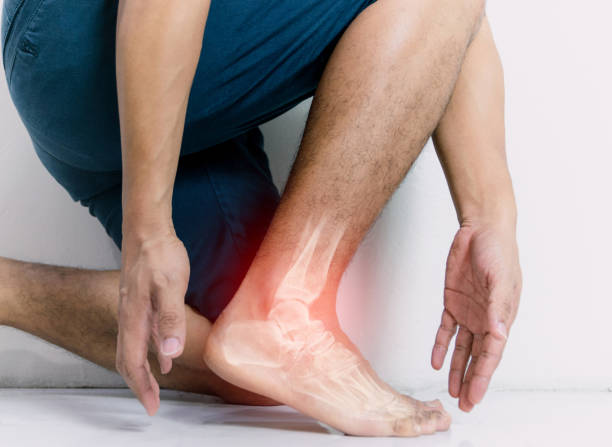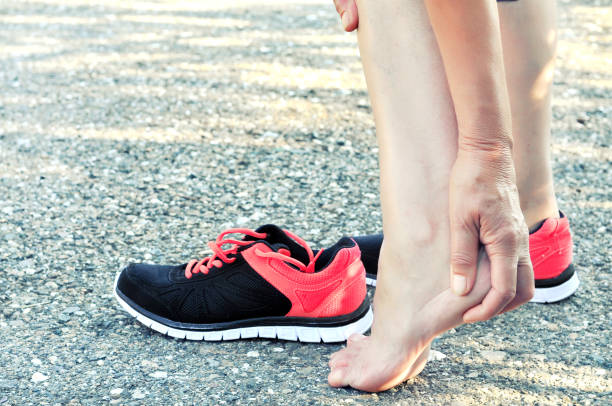If shooting heel pain is keeping you from leading the active life you desire, it’s time to take action. Start by following these 5 effective treatment options:
Rest, ice and elevation — familiar advice that’s often overlooked. Also, try switching from high impact exercise to low-impact activities that put less strain on the feet and heels.

1. Rest
Taking it easy is an essential first step to healing heel pain. This includes avoiding running and standing for long periods, wearing supportive shoes and placing an ice pack on your heel several times a day.
Over-the-counter pain relievers such as acetaminophen and ibuprofen can help ease your discomfort. You can also use a splint that helps stretch and strengthen the calf muscles and Achilles tendon to decrease heel pain.
Plantar fasciitis is an overuse injury that occurs when the plantar fascia, which runs across the bottom of your foot and connects the base of your toes to your heel bone, becomes inflamed. Resting, icing and using heel cups or felt pads can help treat this condition.
2. Ice
Heel pain is often caused by overuse, so resting and icing the area can greatly improve recovery. The RICE method (rest, ice, compression, and elevation) is a great way to treat heel pain at home.
You can use a simple ice pack by wrapping a towel around a plastic bag filled with cubes or crushed ice, and then putting it on your heel for 20 minutes several times per day. There are also special ice therapy slippers available that make this process much easier and more convenient.
Icing is a very effective treatment option, and it doesn’t have any downsides. Your podiatrist in Albany, WA can recommend additional at-home treatments for healing and prevention of heel pain, including stretches to help loosen tight calf muscles.

3. Over-the-Counter Pain Relievers
The feet carry us from place to place each day. But when they hurt, it can be hard to get around and do the things you enjoy.
Chronic plantar fasciitis can cause a heel spur — a calcium deposit that develops where the fascia tissue band connects to the heel bone. Runners and basketball players are more prone to Achilles tendinitis, an overuse injury that inflames the long, strong tendon.
NSAIDs (aspirin, ibuprofen and naproxen) block prostaglandins that trigger pain and swelling. But be cautious and experiment with the best dose for you. Too much NSAID can increase your risk of stomach ulcers and other side effects.
4. Physical Therapy
Often, heel pain is caused by small tears in the plantar fascia that connects the heel to the arch of the foot. Excessive strain on the foot can cause this to happen, such as long periods of standing at work or walking barefoot or wearing shoes with poor support.
Heel pain treatment Albany can effectively treat this issue by easing the inflammation of the heel and improving foot and ankle flexibility can also help ease pain by providing exercises and taping the foot to improve foot posture. These are all great preventative measures that can help reduce the need for more drastic treatments, like surgery or reliance on medication.
5. Orthotics
Studies have shown that orthotics, along with a few simple exercises, can significantly reduce heel pain. Orthotics support the arches and help distribute pressure more evenly, reducing stress on the heel and ankle.
A doctor can prescribe soft or rigid supports that fit inside your shoes. Soft supports are made from foam and gel, while rigid supports are stiffer and can better control abnormal foot biomechanics.
A doctor may also recommend a night splint, which is comfortable to sleep in and keeps the foot in one position, providing a constant stretch for the plantar fascia ligament while you’re sleeping.
6. Cross-Training
If you have mild heel pain that does not get worse during or after activity, cross-training is a great way to maintain a healthy fitness level while protecting your feet. This can include things like swimming, using the elliptical machine, yoga, and cycling.
Heel pain is a common problem that occurs in people who regularly run or spend a lot of time on their feet. It often starts as a sharp, stabbing pain under the heel that gradually improves as you move around.
It is important to take a break from running if you have heel pain, as pushing through it can aggravate your injury and lead to further problems.
7. Taking Breaks
Taking breaks from activities that strain your feet is an effective way to treat heel pain. This allows your arch and heel to heal. Be sure to follow the RICE (rest, ice, compression and elevation) method for best results.
Heel pain often comes from overuse and can be caused by a variety of conditions. Most commonly, it results from faulty biomechanics and walking gait abnormalities that put excessive stress on the heel bone and surrounding soft tissues. Other causes include being overweight; running or jumping on hard surfaces; wearing poorly constructed footwear, especially flip-flops; and injury.
Overuse can also cause bursitis, which occurs when the fluid-filled sacs (bursae) that cushion and lubricate joints swell up. This often causes a tender, bruise-like feeling in the back of your heel.
8. Medications
Heel pain usually develops when the heel bone bruises or the surrounding tissues are irritated. This may occur due to repeated stress on the heels, such as in high-impact sports or while standing for long periods of time, or from carrying excess weight.
Over-the-counter NSAIDs, such as acetaminophen or ibuprofen, can help reduce pain and swelling. Changing activities that put excessive pressure on the feet, such as running and jumping, or having tight calf muscles, can decrease heel pain.
Using night splints to keep the feet in good position can also reduce heel pain caused by structural issues or poor foot biomechanics. Physical therapy exercises and stretches that improve strength and flexibility can also relieve heel pain.
9. Surgery
Heel pain can affect your ability to exercise and perform your job duties. Over time, this can lead to a sedentary lifestyle and weight gain.
Surgery can be a good option if your heel pain doesn’t improve with home treatment and medication. Your doctor will examine your foot and take X-rays to check for bone fractures, bone alignment, ligament damage and soft tissue problems.
Surgical treatment can help with plantar fasciitis (a condition that causes heel pain) and bursitis. This involves cutting or detaching the plantar fascia, which can remove stress on the area and reduce inflammation.